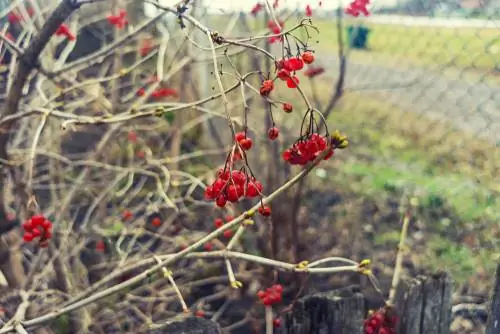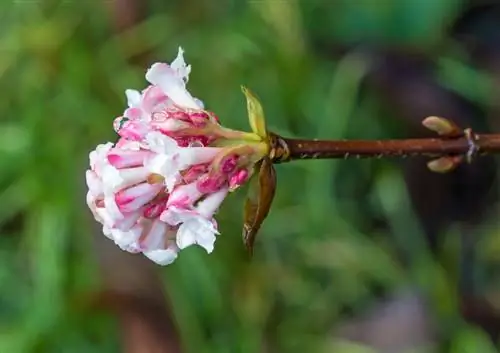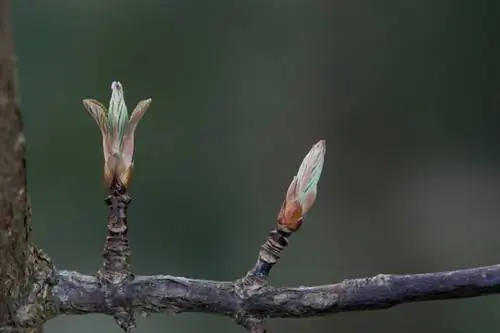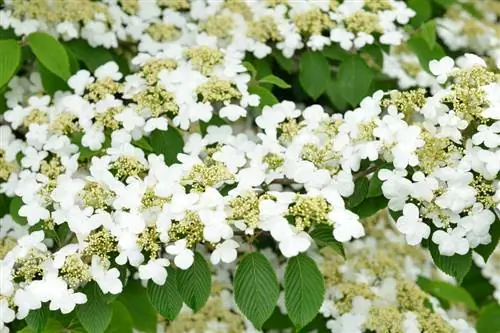- Author admin [email protected].
- Public 2023-12-24 06:09.
- Last modified 2025-01-23 11:21.
A snowball shapes its noble stature with a lavish floral dress on its own initiative. The picturesque tree benefits from an occasional topiary when the ravages of time take its toll. Read this tutorial on when and how to properly prune your viburnum bushes.
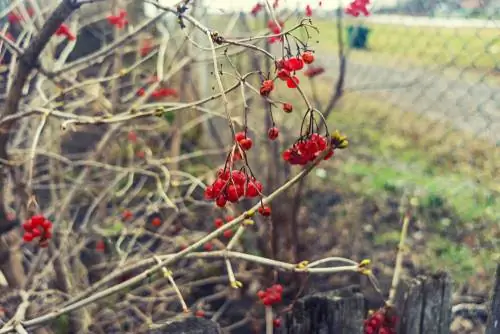
How do I prune my viburnum bush correctly?
To properly prune a viburnum bush, you should first prune in the spring after planting. Older bushes can be pruned sporadically after flowering by removing dead or damaged branches and removing excessively long shoots. Withered flowers should be left for fruit decoration.
Pruning promotes branching
Anyone who decides to cut a freshly planted snowball is taking advantage of an important law of growth. The principle of tip support teaches us that terminal buds are primarily supplied with growth energy. Buds positioned deeper are dormant or sprout only weakly. By cutting off dominant buds, the increased sap pressure stimulates previously subordinate eyes to grow. The result is lush branching at the base of the bush. This is how you get the perfect plant cut:
- The best time is in the spring after planting
- Bare-rooted young bushes: cut back all shoots by a third or half
- Rule of thumb for cutting: the weaker the young shoots, the stronger the plant cut
- Poted goods with root balls: cut off damaged, weak shoots, do not cut remaining shoots
Before you plant a bare-root viburnum bush in the ground, please examine the roots carefully. Please cut off any root strands that are kinked, torn or damaged in any other way. If the roots are too long, shorten them to a length of 20 to 25 centimeters.
Tip
Some of the most beautiful viburnum species have leaves that are covered with delicate fibers. Allergy and asthma sufferers should wear a breathing mask and protective goggles when cutting the snowball varieties in question to avoid contact with the eyes or respiratory tract with the fine hairs.
Sporadic shaping and maintenance pruning
Its well-formed silhouette forms a snowball under its own power. At a young age, gardening interventions cannot optimize natural beauty. Up to the sixth or eighth year, pruning care is limited to removing snapped or frozen shoots. The image below illustrates how an older viburnum benefits from occasional pruning and maintenance if its vitality begins to decline after eight years at the latest. How to cut a snowball correctly:
- The best time is after the flowering period
- Sharpen the pruning shears, clean them and disinfect them with alcohol
- At the beginning, thin out dead, cross-growing and damaged branches
- Excessively long shoots that lean towards the ground refer to an internal, annual side shoot
At the beginning of the sixth year, you can effectively prevent signs of aging by thinning out the oldest ground shoots every year. As a replacement, use the strongest young shoot that you do not cut in the first few years. Weak ground shoots that sprout as a result of the thinning must give way to a light-flooded, airy viburnum bush.

After 6 to 8 years of standing, a viburnum bush benefits from a shape and maintenance pruning. Excessively long branches lead you to a deeper, annual side shoot. One or two of the oldest ground shoots should be removed to encourage the growth of young shoots.
Excursus
Excessive pruning causes aphid infestation
It is not just aesthetic criteria that prohibit severe pruning of viburnum bushes. Viburnum is characterized by massive sprouting of very long, soft shoots in response to a deep cut. A slow growth rate of 10 to 15 cm per year means that young shoots only woody slowly. These relationships offer ideal conditions for aphids. It is strongly recommended to limit pruning care to what is absolutely necessary. In an emergency, you can fight lice on viburnum with tried-and-tested home remedies, such as the tried and tested soap solution.
Do not clean up wilted flowers
The ball- or plate-shaped flowers turn into blue-black berries by autumn, which decorate a viburnum bush well into winter. On the way there, the withered inflorescences are certainly not a feast for the eyes for a short time. Anyone who tolerates the floral signs of transience will be rewarded with a magnificent fruit decoration. Cleaning out spent viburnum flowers is only advisable in the family garden because unripe berries are slightly poisonous.
Rejuvenate old viburnum in stages
Slow growth and low pruning requirements tempt home gardeners to completely ignore pruning care. Without occasional thinning out of dead wood and slimming of overly long branches, the snowball will age into an impenetrable thicket with few flowers. It's a good thing that most Viburnum species tolerate cutting. Instead of clearing an old, neglected shrub, rejuvenating pruning solves the problem. This is how it works:
- Rejuvenate viburnum in two stages
- The best time is in late winter when temperatures are above freezing
- First year: cut off half of the branches at ground level
- In summer: cut back young shoots by half in July
- Second year: thin out the second half of the ground shoots
- In summer: shorten new ground shoots resulting from the second stage by half
The summer regulatory cut of the new growth primarily promotes stability. Furthermore, the pruning in the lower half causes a sap to accumulate, which helps the rejuvenated snowball to branch lushly at the base. The flowering tree is well positioned with a framework of five to seven ground shoots. Surplus ground shoots should be removed for a successful new structure.
Background
Complete rejuvenation cut in winter
The late winter weeks between mid-January and early March are in many ways the best time to revitalize an old viburnum bush. In the transition from the winter rest period to the summer growth period, the sap pressure increases dramatically. Pruning measures now have the maximum effect on slow-growing Viburnum species, which you can see in the strong shoots. Furthermore, by choosing the winter date, you comply with the regulations of the Federal Nature Conservation Act. Section 39 stipulates that extensive pruning is permitted between October 1st and February 28th. The reason is to protect wild animals, especially breeding birds.
Observe the cutting technique on buds
For whatever reason you decide to cut your snowball, the key to success is the right cutting technique. For the interface, choose a strong bud that faces outward. A distance of 5 millimeters ensures that you neither cut your eye nor leave a long stub. The image below demonstrates how to position the scissors perfectly.
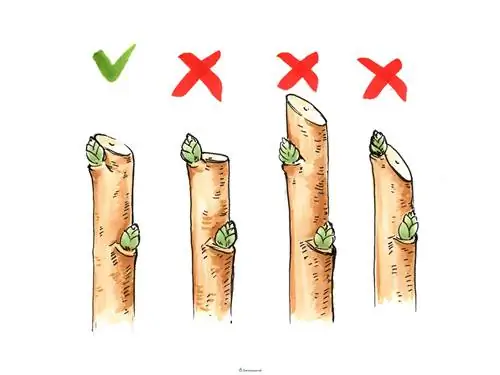
Cut viburnum branches just above a bud. Hold the scissors at a slight angle so that the highest point is exactly above the bud.
Frequently asked questions
Is the snowball poisonous?
All viburnum species and varieties are classified as moderately poisonous plants. Leaves, bark and unripe fruits contain various toxins that, in large quantities, can cause symptoms of poisoning in humans and animals. This does not apply to the ripe, blue-black berries. In Eastern Europe the fruits are harvested in autumn and made into jelly.
A number of shoots with different, lobed leaves grow all around our snowball 'Aurora'. Could it be wild shoots?
Viburnum carlesii 'Aurora' is a refinement. For this reason, it is not uncommon for wildlings to sprout from the rootstock. The different leaves are a clear indication. Remove the wild shoots directly from the roots with a courageous tug or a cut as deep as possible. This prevents the growth of further wildlings.
Should I leave the withered flowers to enjoy the fruit decoration or can the unsightly, brown remains be cut off?
The decorative berries can only develop if you leave withered flowers on the viburnum. Early-flowering and frost-sensitive evergreen viburnum varieties often suffer from frozen inflorescences after severe night frosts. No more fruit can form from this, so you can remove the dead remains.
Last year we planted a winter snowball that actually bloomed in February. Then the big snow came at the beginning of March, which left behind a more than poor bush. What can we do?
A young viburnum bush in particular benefits from cutting back its shoots to stimulate branching. Even if more flowers and buds fall victim to cutting, you should cut all branches back by half. Thin out any shoots that have collapsed due to snow pressure.
I have never cut my 10 year old viburnum. How does it work? When is the best time?
After the flowering period is the optimal time for pruning. Cut the bush back by about a third on all sides. A rounded shape is ideal for light-flooded growth. Remove dead and visibly diseased wood completely.
The 3 most common cutting mistakes
If viburnum's good-natured pruning tolerance seduces gardeners into radical pruning, long, soft shoots and aphid infestation are inevitable. Cleaning out withered flowers robs the viburnum of its pretty berries. The following overview draws attention to three common pruning mistakes on snowball bushes with tips for careful prevention:
| Cutting errors | malicious image | Prevention |
|---|---|---|
| cut too radical | Sprout of long, soft shoots, aphid infestation | occasionally thin out, remove isolated overlong branches |
| withered flowers cut off | no autumnal fruit decorations | do not clean out dead viburnum |
| blunt pruning shears used | ragged cuts, spread of disease | Sharpen scissor blades freshly and carefully disinfect them |

Tip
The rare need for pruning does not mean that you have to forgo the easy propagation of your most beautiful viburnum bushes through cuttings. Early summer is the best time to cut off half-woody, non-flowering shoot tips that are 8 to 15 centimeters long. The lower half is defoliated before you plant each cutting in a pot with potting soil and water it.

